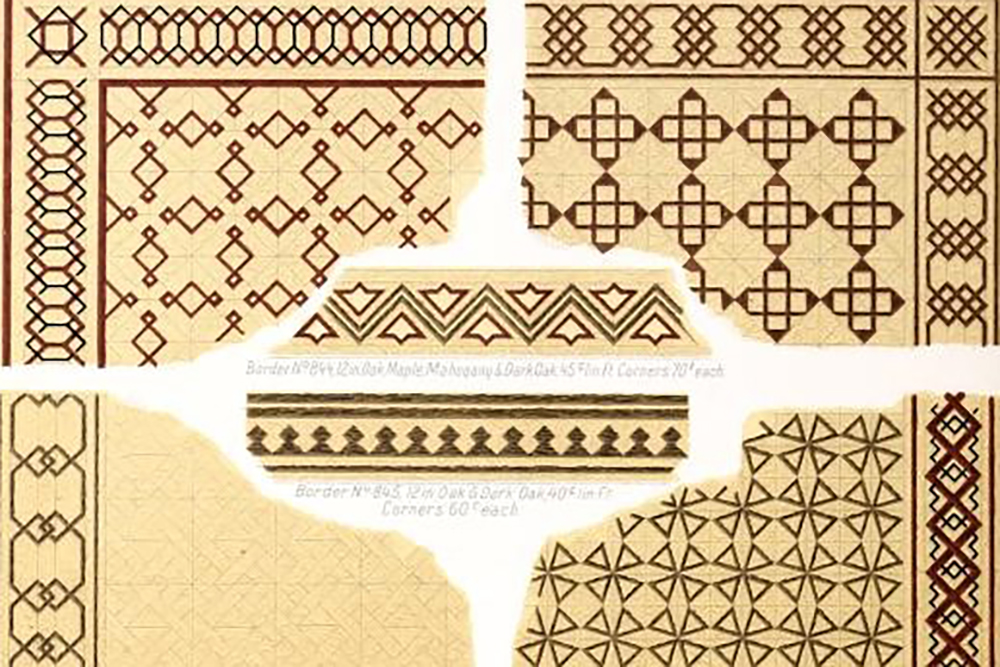This post is part of a monthly series that explores the historical applications of building materials and systems through resources from the Building Technology Heritage Library (BTHL), an online collection of AEC catalogs, brochures, trade publications, and more. The BTHL is a project of the Association for Preservation Technology, an international building preservation organization. Read more about the archive here.
The urge to embellish can be found in art throughout history, but beginning in the mid-19th century, design publications such as Owen Jones’ The Grammar of Ornament began organizing the history of what he called “Ornamental Art.” Jones identified 20 categories of ornament largely based upon their ethnic, regional, and historical periods, using terms—such as Egyptian or Renaissance—that still resonate today.
There are nearly 400 documents with the word “ornamental” in the BTHL meta data and a smaller number with the word “ornament.“ The term was particularly popular in the early 20th-century publications, with interior decorative materials, such as plaster and wallpapers, serving as two of the most obvious materials offered to create a variety of motifs. Some of the earliest trade catalogs in the BTHL show the use of ornament for plaster walls. Some of these walls were created with a cast paper or resin product known as carton-pierre, which originated in 18th-century France. In the 20th century, several major U.S. companies produced cast ornament in plaster and composites, marketing their innovations in large, photograph-filled publications.
Some exterior building elements also became a canvas for cast or stamped ornamental patterns. Embellishments made from ornamental stamped sheet metal generally copied designs that originated in sculpted stone or plaster. The same could be said for terra cotta, which replaced carved stone for masonry materials in the early 20th century for its economy of duplicating ornamental. Whatever the materials, the documents in the BTHL reveal the rich history of ornament in architecture and the development of labor-saving methods of embellishment and mass production.
No. 1, Containing 12 Plates Engraved in Aqua-Tinta, Jee & Eginton, Birmingham, England, 1784
This is one of the oldest documents in the BTHL. The publication does not include text, just 12 plates with images of “detached ornaments” for use by “ingenious architects.” The materials is described as “composition,” a combination of fillers with a plaster base.
Recueil de Dessins, d’Ornemens, d’Architecture Lithographiés, Tirrart, Paris, 1830
The title is a collection includes images of 108 plates with more than 1,100 different ornamental patterns. The buildings constructed from these materials are even more impressive when you consider the humble log cabins being built in the United States at the time.
Outlines of Ornament in the Leading Styles, W & G Audsley, London, 1881
Outlines in Ornament used a classification system that connected design patterns to regional locations or historic periods. These patterns were fret, fret diaper, interlaced, powdered, diaper, and conventional foliage. There are 59 black-and-white plates and hundreds of different motifs.
Catalogue of Architectural Ornaments and Statuary, in Sheet Zinc, Brass, or Copper, W. H. Mullins Co., Salem, Ohio, 1894
The mass production of architectural ornament in stamped sheet metal expanded rapidly in the 1870s and was widely available through the 1920s. Motifs that would have been produced in plaster were made in zinc-coated sheet metal, which made this material quite durable for exterior applications.
Art Moulding: Grand Rapids Carved Moulding Co.: highest award Columbian Exposition, Grand Rapids Carved Moulding Company, Grand Rapids, Mich.,1894
This company made wood moldings manufactured using carving machinery. The moldings could be purchased in 6- and 12-foot lengths.
Ornamental Hardwood Floors: Parquetry, Borders, Strips, Floor Finishes, Weighted Brushes, S. C. Johnson & Son, Racine Junction, Wis., 1901
Wood strip flooring using a variety of woods and extensive use of patterns could transform the floor from a simple flat surface into a large ornamental pattern.
1904 Catalogue: Stephen Bilek Co., Stephen Bilek Co., Chicago, 1904
The title says “embossed moldings” but the description includes “dropped carvings, ornaments, and turnings.” These were all available in oak or birch and other woods could be provided.
Architectural Ornaments in Exterior and Interior: Composition, Wood, Cement, Maxwell, Forbes, Stillman Co., Milwaukee, Wis., 1909
This catalog is typical of several different U.S. companies that produced plaster and composition ornament. They often featured photo plates with individual pieces shown against a black background.
A Few Suggestions For Ornamental Decoration: A Collection of Designs & Colour Schemes for Painters’ and Decorators’ Work, Thos. Parsons & Sons, London, 1908
The “few suggestions” in this publication number in the hundreds with both color and black-and-white illustrations of interior decorating schemes.
Ornamental iron and bronze executed by the Winslow Bros. Co., Winslow Brothers Co., Chicago, 1910
The Winslow Brother Co. of Chicago was an important U.S firm in the production of ornamental metal for major commercial buildings. This is not so much a catalog as it is a monograph of the companies many projects.
Excelsior Fresco Stencils, Geo. E. Watson Co., Chicago, 1924
With more than 200 pages and thousands of designs for stencils, this catalog is a virtual encyclopedia of stencil patterns popular in the 1920s.
Composition Ornament; Examples in the Moderne Style, Chicago Decorating Co., Chicago, 1935
This catalog of “composition ornaments” is noteworthy for the new style of ornament that came with the Art Deco and Art Moderne design movements of the 1930s. This company still produced a great variety of period designs in plaster, but produced a small catalog to showcase their new designs.
